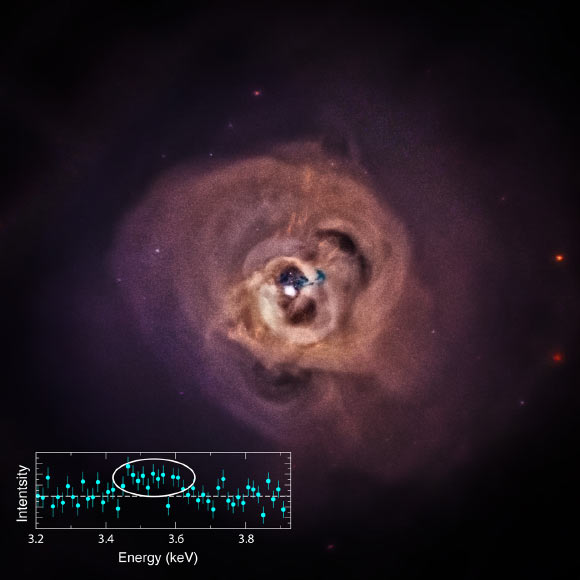Astronomers using ESA’s XMM-Newton and NASA’s Chandra X-ray observatories have detected an unidentified X-ray emission line – a spike of intensity at a very specific wavelength of X-ray light – in the Andromeda galaxy, the Perseus galaxy cluster and 73 other galaxy clusters. One intriguing possibility is that these X-rays are produced by the decay of sterile neutrinos, a type of particle that has been proposed as a candidate for dark matter.

X-ray image of the Perseus galaxy cluster: a new study of the cluster has revealed a mysterious X-ray signal; this signal is represented in the circled data points in the inset, which is a plot of X-ray intensity as a function of X-ray energy. Image credit: Chandra / NASA / CXC / SAO / XMM / ESA / E. Bulbul et al.
Scientists think dark matter constitutes 85 per cent of the matter in the Universe, but does not emit or absorb light like ‘normal’ matter such as protons, neutrons and electrons that make up the familiar elements observed in planets, stars, and galaxies.
Because of this, they must use indirect methods to search for clues about dark matter.
“We know that the dark matter explanation is a long shot, but the pay-off would be huge if we’re right. So we’re going to keep testing this interpretation and see where it takes us,” said Dr Esra Bulbul of the Harvard-Smithsonian Center for Astrophysics in Cambridge.
Dr Bulbul and his colleagues suggest the X-ray emission line detected in the Andromeda galaxy and 74 galaxy clusters could be a signature from the decay of a ‘sterile neutrino.’
The discovery is described in two papers (arXiv.org pre-prints: paper 1 & paper 2), one of which has been published in the Astrophysical Journal.
Sterile neutrinos are a hypothetical type of neutrino that is predicted to interact with normal matter only via gravity.
Some scientists have proposed that such neutrinos may at least partially explain dark matter.
“We have a lot of work to do before we can claim, with any confidence, that we’ve found sterile neutrinos. But just the possibility of finding them has us very excited,” said Dr Maxim Markevitch from NASA’s Goddard Space Flight Center in Greenbelt, Maryland, who is a co-author of the ApJ paper.
One source of uncertainty is that the detection of this emission line is pushing the capabilities of XMM-Newton and Chandra X-ray observatories in terms of sensitivity.
Also, there may be explanations other than sterile neutrinos if this X-ray emission line is deemed to be real.
There are ways that normal matter in these objects could have produced the line, although the discovery suggested that all of these would involve unlikely changes to our understanding of physical conditions in them or the details of the atomic physics of extremely hot gases.
Even if the sterile neutrino interpretation is correct, their detection does not necessarily imply that all of dark matter is composed of these particles.
“Our next step is to combine data from Chandra and JAXA’s Suzaku mission for a large number of galaxy clusters to see if we find the same X-ray signal,” said Dr Adam Foster, a scientist with Harvard-Smithsonian Center for Astrophysics and a co-author of the ApJ paper.
______
Esra Bulbul et al. 2014. Detection of an Unidentified Emission Line in the Stacked X-Ray Spectrum of Galaxy Clusters. ApJ 789, 13; doi: 10.1088/0004-637X/789/1/13
Alexey Boyarsky et al. 2014. An unidentified line in X-ray spectra of the Andromeda galaxy and Perseus galaxy cluster. arXiv: 1402.4119







